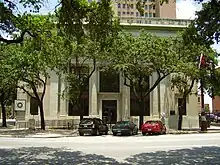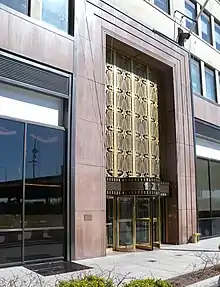National Urban League
The National Urban League, formerly known as the National League on Urban Conditions Among Negroes, is a nonpartisan historic civil rights organization based in New York City that advocates on behalf of economic and social justice for African Americans and against racial discrimination in the United States.[1] It is the oldest and largest community-based organization of its kind in the nation. Its current President is Marc Morial.
 | |
| Formation | September 29, 1910 |
|---|---|
| Founder | Ruth Standish Baldwin George Edmund Haynes |
| Founded at | New York City |
President | Marc Morial |
| Website | nul |
History


The Committee on Urban Conditions Among Negroes was founded in New York City on September 29, 1910, by Ruth Standish Baldwin and Dr. George Edmund Haynes, among others.[2] It merged with the Committee for the Improvement of Industrial Conditions Among Negroes in New York (founded in New York in 1906) and the National League for the Protection of Colored Women (founded in 1905), and was renamed the National League on Urban Conditions Among Negroes.[3][4] Haynes served as the organization's first Executive Director.
In 1918, Eugene K. Jones took the leadership of the organization. Under his direction, the League significantly expanded its multifaceted campaign to crack the barriers to black employment, spurred first by the boom years of the 1920s, and then by the desperate years of the Great Depression.[5]
In 1920, the organization took the present name, the National Urban League.[6] The mission of the Urban League movement, as stated by the National Urban League, is "to enable African Americans to secure economic self-reliance, parity, power and civil rights."[7] When the organization expanded its facilities to conduct more research in 1920, the new Department of Research came under the charge of Lillian Anderson Turner Alexander, a rising civil rights activist recruited by Jones.[8]
Jones played a significant role in President Franklin D. Roosevelt's administration, taking leave from the League to head the Department of Commerce unit for the study of "Negro problems", and serving as part of a group of African-American advisors known as the "Black Cabinet".[9]
In 1941, Lester Granger was appointed Executive Secretary and led the NUL's effort to support the March on Washington proposed by A. Philip Randolph, Bayard Rustin and A. J. Muste to protest racial discrimination in defense work and the military.[10] A week before the March was scheduled to take place, President Roosevelt issued an executive order creating the Fair Employment Practices Committee.[9]
In the wake of World War II, Black veterans who fought racial hatred overseas returned to the United States determined to fight it at home, giving new energy to the Civil Rights Movement. As hundreds of thousands of new jobs opened up, shifting the economy from industrial manufacturing to a white-collar, service-oriented economy, the National Urban League turned its attention to placing HBCU graduates in professional positions.[9]
In 1961, Whitney Young became executive director amidst the expansion of activism in the civil rights movement, which provoked a change for the League. Young substantially expanded the League's fund-raising ability and made the League a full partner in the civil rights movement.[9] In 1963, the League hosted the planning meetings of A. Philip Randolph, Martin Luther King Jr. and other civil rights leaders for the August March on Washington for Jobs and Freedom. During Young's ten-year tenure at the League, he initiated programs such as "Street Academy", an alternative education system to prepare high school dropouts for college; and "New Thrust", an effort to help local black leaders identify and solve community problems. Young also pushed for federal aid to cities.
Clarence M. Pendleton, Jr., was, from 1975 to 1981, the head of the Urban League in San Diego, California. In 1981, U.S. President Ronald W. Reagan tapped Pendleton as the chairman of the United States Commission on Civil Rights, a position which he held until his sudden death in 1988. Pendleton sought to steer the commission into the conservative direction in line with Reagan's views on social and civil rights policies.[11]
In 1994, Hugh Price was appointed as president of the Urban League.
In 2003, Marc Morial, former mayor of New Orleans, Louisiana, was appointed the league's eighth President and Chief Executive Officer. He worked to reenergize the movement's diverse constituencies by building on the legacy of the organization and increasing the profile of the organization.[12]
Current status
Today, the National Urban League has 90 affiliates serving 300 communities, in 37 states and the District of Columbia. The National Urban League provides direct services in the areas of education, health care, housing, jobs, and justice—providing services to more than 2 million people nationwide. The organization also has a Washington Bureau that serves as its research, policy and advocacy arm on issues relating to Congress and the Administration.[13]
The National Urban League is an organizational member of the Coalition to Stop Gun Violence, which advocates gun control. In 1989, it was the beneficiary of all proceeds from the Stop the Violence Movement and their hip hop single, "Self Destruction".[14]
In May 2017, the National Urban League produced the State of Black America TV Town Hall, which aired on TV One in 2017 and 2018.[15] The TV Town Hall elevated social issues related to African Americans through an interview style format with celebrity guests. The show was executive produced by Rhonda Spears Bell.
In February 2018, the National Urban League launched a weekly podcast, For the Movement, which discusses persistent policy, social and civil rights issues affecting communities of color.[16]
State of Black America
The State of Black America is an annual report published by the league.[17][18]
Presidents
The Presidents (or Executive Directors) of the National Urban League have been:[19]
| Presidents | From | To | Background |
| George Edmund Haynes | 1910 | 1918 | social worker |
| Eugene Kinckle Jones | 1918 | 1940 | civil rights activist |
| Lester Blackwell Granger | 1941 | 1961 | civic leader |
| Whitney Moore Young, Jr. | 1961 | 1971 | civil rights activist |
| Vernon Eulion Jordan, Jr. | 1971 | 1981 | attorney |
| John Edward Jacob | 1982 | 1994 | civil rights activist |
| Hugh Bernard Price | 1994 | 2002 | attorney foundation executive |
| Marc Haydel Morial | 2003 | Current | attorney |
See also
References
- "Mission and History". National Urban League. Retrieved 12 April 2020.
- Parris, Guichard and Lester Brooks. Blacks in the City: A History of the National Urban League. Boston: Little, Brown and Company. 1971. p. 28.
- Dodson, N. "New Chapter in Social Uplift." Afro-American (1893–1988): 2. Dec 30 1911. ProQuest. Web. 6 Feb. 2016.
- Parris, Guichard and Lester Brooks. Blacks in the City: A History of the National Urban League. Boston: Little, Brown and Company. 1971. pp. 32–34.
- Armfield, Felix L. Eugene Kinckle Jones: The National Urban League and Black Social Work, 1910–1940. Urbana : University of Illinois Press, 2012.
- Parris, Guichard and Lester Brooks. Blacks in the City: A History of the National Urban League. Boston: Little, Brown and Company. 1971.
- "Mission and History." National Urban League. Accessed 6 February 2016.
- "Urban League Activities". The New York Age. 6 March 1920. p. 8. Retrieved 2022-08-15 – via Newspapers.com.
- Smith, Alonzo (2011). Empowering Communities, Changing Lives: 100 Years of the National Urban League. New York City: The Donning Company. p. 72. ISBN 978-1578646838.
- Thomas, Jesse. "Urban League Bulletin." The Atlanta Constitution (1881–1945): 1. Jan 25 1942. ProQuest. Web. 6 Feb. 2016.
- "Notable Kentucky African Americans Database". uky.edu. Retrieved March 19, 2013.
- "The Honorable Marc H. Morial". The History Makers. Retrieved 2023-04-22.
- "About NUL". Retrieved 2022-05-15.
- "National Urban League". Almazenye. Retrieved 2022-05-15.
- "The National Urban League's State of Black America Townhall: How Far Have We Really Come?". TV One. 2017-05-17. Retrieved 2021-01-17.
- "For The Movement on Apple Podcasts". Apple Podcasts.
- "The Fine Print In The 'State Of Black America' Report". NPR.org. Retrieved 2018-05-04.
- "The National Urban League just released a report that shows black America has a lot to worry about under Trump". Mother Jones. Retrieved 2018-05-04.
- "Mission and History". IAmEmpowered.com. Retrieved 2023-04-22.
Further reading
- Carle, Susan D. Defining the Struggle: National Racial Justice Organizing, 1880–1915 (Oxford UP, 2013). 404pp. focus on NAACP and also Urban League.
- Hamilton, Dona Cooper. "The National Urban League and New Deal Programs." Social Service Review (1984): 227–243. in JSTOR
- Parris, Guichard and Lester Brooks. Blacks in the City: A History of the National Urban League. Boston: Little, Brown and Company, 1971.
- Strickland, Arvarh E. History of the Chicago Urban League (U of Missouri Press, 1966).
- Touré F. Reed, Not Alms but Opportunity: The Urban League and the Politics of Racial Uplift, 1910–1950. (University of North Carolina Press, 2008). online
- Weiss, Nancy Joan. The National Urban League, 1910–1940 (Oxford University Press, 1974).
- Wood, L. Hollingsworth. "The Urban League Movement." Journal of Negro History 9.2 (1924): 117–126. in JSTOR
External links
- National Urban League website
- National Urban League Young Professionals Website
- State of Black America
- Radio drama about the Northern Migration and how it gave birth to the league – "The Birth of a League", a presentation from Destination Freedom
Archives
- National Urban League Records (1900–1988) held at the Library of Congress Manuscripts Division
- Greater Lansing Urban League, Inc. 1964–1976. At the Bentley Historical Library University of Michigan
- The Seattle Urban League Records 1930–1997. 103.2 cubic feet. At the Labor Archives of Washington, University of Washington Libraries Special Collections.
- Civic Unity Committee Records. 1938–1965. 24.8 cubic feet (58 boxes). Contains material related to the National Urban League, Seattle Urban League, and Portland Urban League. At the Labor Archives of Washington, University of Washington Libraries Special Collections.